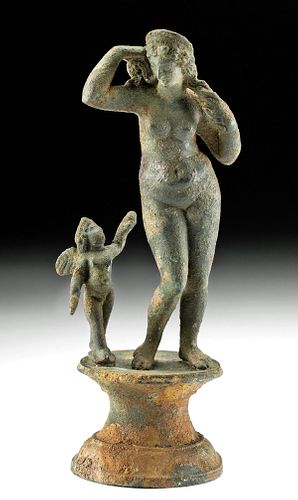Exhibited Romano-Egyptian Bronze Venus & Cupid
Lot 13
About Seller
Artemis Fine Arts
686 S Taylor Ave, Ste 106
Louisville, CO 80027
United States
Selling antiquities, ancient and ethnographic art online since 1993, Artemis Gallery specializes in Classical Antiquities (Egyptian, Greek, Roman, Near Eastern), Asian, Pre-Columbian, African / Tribal / Oceanographic art. Our extensive inventory includes pottery, stone, metal, wood, glass and textil...Read more
Estimate:
$24,000 - $36,000
Absentee vs Live bid
Two ways to bid:
- Leave a max absentee bid and the platform will bid on your behalf up to your maximum bid during the live auction.
- Bid live during the auction and your bids will be submitted real-time to the auctioneer.
Bid Increments
| Price | Bid Increment |
|---|---|
| $0 | $25 |
| $300 | $50 |
| $1,000 | $100 |
| $2,000 | $250 |
| $5,000 | $500 |
| $10,000 | $1,000 |
| $20,000 | $2,500 |
| $50,000 | $5,000 |
| $100,000 | $10,000 |
| $200,000 | $20,000 |
About Auction
By Artemis Fine Arts
Oct 8, 2020
Set Reminder
2020-10-08 10:00:00
2020-10-08 10:00:00
America/New_York
Bidsquare
Bidsquare : Exceptional Antiquities, Asian, Ethnographic
https://www.bidsquare.com/auctions/artemis-gallery/exceptional-antiquities-asian-ethnographic-5796
Museum-worthy examples of Egyptian, Greek, Roman, Etruscan, Near Eastern, Far East / Asian, Pre-Columbian, African / Tribal,Oceanic, Native American, Spanish Colonial, Russian, Fossils, Ancient Jewelry, Fine Art, so much more! Artemis Fine Arts info@artemisfinearts.com
Museum-worthy examples of Egyptian, Greek, Roman, Etruscan, Near Eastern, Far East / Asian, Pre-Columbian, African / Tribal,Oceanic, Native American, Spanish Colonial, Russian, Fossils, Ancient Jewelry, Fine Art, so much more! Artemis Fine Arts info@artemisfinearts.com
- Lot Description
Egypt, Romano-Egyptian, ca. 1st century BCE to 1st century CE. Skillfully cast via the lost wax (cire perdue) process, a leaded bronze statue of Venus (Greek Aphrodite), the goddess of love and beauty, and her son Cupid (Greek Eros), the god of sexual desire, love, and attraction - both standing upon a spool-shaped pedestal. The goddess is nude and presents with a curvaceous figure. She stands in contrapposto with her left knee bent and her weight shifted, while her arms are raised as she playfully arranges her tresses. Her beautiful visage presents with delicate features and is framed by her centrally-parted wavy coiffure which is adorned by a diadem. The winged, nude Cupid below and to Venus' right looks up at the goddess, presenting her with an apple in his outstretched left hand - a reference to the Judgement of Paris and Venus' reward for winning the legendary beauty contest between she Juno (Hera) and Minerva (Athena). Size: 7" H (17.8 cm)
Cupid (Eros) was the mischievous yet endearing god of love, a minion, constant companion, and according to some classical writers, a son of the goddess Venus (Aphrodite). In the Roman period, Cupid had become a child (to the earlier Greeks, he was a muscular youth). Here he retains his mischievous air, ready to help couples fall in love through not-entirely-innocent interventions with the fruit of the vine.
Venus presents with ample, curvaceous proportions - some might call her Zaftig - an indication of an earlier dating than the classical Roman period. For instance, Praxiteles' infamous "Aphrodite of Knidos" (ca. 360-330 BCE) possesses a soft belly and several dimples on her back. What's more, the anatomy of the "Lely's Venus" (ca. 100 to 199 CE) also displays voluptuous folds and rolls. Venus/Aphrodite was the Goddess of Love and beauty and her shapely form was the ideal phenotype for women of the time.
Published: J. Eisenberg, Art of the Ancient World , vol. IV (1985), no. 282.
On loan to Ohio State University; Picker Art Gallery, Colgate University; Fitchburg Art Museum from 1986 to 2016.
Provenance: private M.K. collection, St. Clair Shores, Michigan, USA, acquired from Royal-Athena in July 1986 - Published: J. Eisenberg, Art of the Ancient World , vol. IV (1985), no. 282.
On loan to Ohio State University; Picker Art Gallery, Colgate University; Fitchburg Art Museum from 1986 to 2016.
All items legal to buy/sell under U.S. Statute covering cultural patrimony Code 2600, CHAPTER 14, and are guaranteed to be as described or your money back.
A Certificate of Authenticity will accompany all winning bids.
We ship worldwide and handle all shipping in-house for your convenience.
#158233Figures reattached to original pedestal. Both the figures and pedestal base present with green and russet patina with areas of encrustation that have developed over the ages. Old collection number handwritten on underside of pedestal.Condition
- Shipping Info
-
All shipping is handled in-house for your convenience. Your invoice from Artemis Gallery will include shipping calculation instructions. If in doubt, please inquire BEFORE bidding for estimated shipping costs for individual items.
-
- Buyer's Premium



 EUR
EUR CAD
CAD AUD
AUD GBP
GBP MXN
MXN HKD
HKD CNY
CNY MYR
MYR SEK
SEK SGD
SGD CHF
CHF THB
THB














